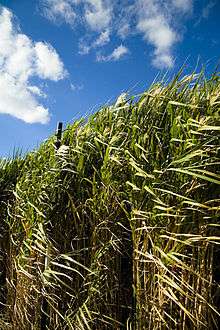Miscanthus giganteus
| Miscanthus | |
|---|---|
 | |
| Miscanthus × giganteus | |
| Scientific classification | |
| Kingdom: | Plantae |
| (unranked): | Angiosperms |
| (unranked): | Monocots |
| (unranked): | Commelinids |
| Order: | Poales |
| Family: | Poaceae |
| Subfamily: | Panicoideae |
| Genus: | Miscanthus Keng |
Miscanthus × giganteus, giant miscanthus,[1] is a large, perennial grass hybrid of Miscanthus sinensis and Miscanthus sacchariflorus. This full sun plant grows 8–12 ft (240–360 cm) tall each year and is best suited for hardiness Zones 5 - 9.[2][3]
Physiology
M. × giganteus is a C4 plant, and thus exhibits greater photosynthetic efficiency and lower water use requirements than other kinds of plants.[4] It has very low nutritional requirements – it has high nitrogen use efficiency and therefore is capable of growing well on barren land without the aid of heavy fertilization. M. × giganteus is a sterile hybrid and therefore propagates vegetatively underground through its rhizomes.[5] Additional researched benefits of M. × giganteus include its ability to sequester carbon into the earth.[6]
Uses
Biofuels
It is currently used in the European Union as a commercial energy crop, as a source of heat and electricity, or converted into biofuel products such as ethanol.[7]
Research trials being conducted in the United Kingdom, United States and Ireland are making strides towards developing Miscanthus x giganteus as a source of biomass for the production of energy either for direct combustion or through cellulosic ethanol or other biofuel production.[8] Miscanthus is grown in Europe mainly for cofiring in coal power generating facilities, and could supply 12% of the EU's energy need by 2050.[9] In the United States, SunBelt Biofuels founder Phillip Jennings has worked with Mississippi State's Brian Baldwin to develop a more effective, marketable Miscanthus grass strain. SunBelt has since been renamed REPREVE Renewables, and has developed a program to distribute the strain to growers, refiners, and others interested in the plant (dubbed "FREEDOM giant miscanthus",[10] as the company hopes to reduce American dependence on foreign oil).
In a significant development for the large scale production of this energy crop, Aloterra Energy LLC was approved by the USDA in 2011 to manage four Miscanthus × giganteus energy crop projects under a 2008 Farm Bill program named the Biomass Crop Assistance Program (BCAP).[11][12] These projects are being operated by Aloterra Energy LLC and MFA Oil Biomass LLC (a partnership between Aloterra Energy LLC and MFA Oil Company). Each BCAP Project Area is projected to establish 50,000 acres of Miscanthus to initially convert into solid fuel pellets.[13] As technologies develop, their miscanthus will be used to create renewable liquid fuels and biobased chemicals and products. As part of the USDA BCAP program, Aloterra Energy and MFA Oil Biomass are working together on an initial planting of approximately 18,000 acres of miscanthus in 2012.[14]
Carbon Sequestration and Seasonal Fluxes
Miscanthus has the potential to sequester carbon in the soil. Sequestered carbon generally refers to atmospheric carbon that has been stored as living or dead organic matter. Plants sequester carbon by in-taking atmospheric CO2 and assimilating it as plant tissue, leaves or roots, and sharing with its microbial partners in the soil,[6] or above the soil as leaf litter or other dead plant matter.[15] Clifton-Brown et al. 2007 reports a sequestration of 0.6 t C per ha per year. This carbon sequestering adds to the fossil fuel offset to give the net offset of Miscanthus as a bioenergy crop.
The seasonal soil gas fluxes show the emissions from the land under different crops, climate patterns and management practices. This is the main way that sequestered carbon returns to the atmosphere.[16] Clifton et. al. studied Miscanthus for 16 years in southern Ireland.[6] They examined soil cores for the ratio of 13C/12C in the top 30 cm of soil They determined that the sequestration over 15 years was 8.9+/-2.4 t C per hectare per year. To properly evaluate the C sequestration potential for any agricultural management system, the seasonal C fluxes should be considered. The low fertilizer, pesticide, and water requirements of Miscanthus means that the emissions associated with such typical agricultural processes are avoided. Miscanthus is a perennial grass, which allows it to avoid tillage that destroys soil structures and emits soil carbon.[17] Other environmental issues that are caused by fertilizer run-off are also avoided.[18] If the land under typical agricultural management is converted to a low-input alternative like Miscanthus, the change in land management would create a negative C land use change.[19] Carbon dynamics are important if a system would occupy a large amount of land because carbon sinks could mitigate GHGs.
Plastics and Nanocellulose
Manufacturers such as AgriKinetics, NNRGY Crops, and Aloterra are currently exploring the possibility of using Miscanthus grass as input for plastics and other products traditionally constructed from petroleum fuels, trees or land resources (for example limestone).
Bedding
Miscanthus × giganteus is also used as a high-quality bedding typically for equine applications. Miscanthus has a very high C:N ratio making it inhospitable to many microbes thus creating a very clean and antibacterial bedding.[20]
Game Crop / Cover Crop
Miscanthus × giganteus is also used as a cover crop providing shelter for game birds such as pheasants and partridges the advantage being that they do not need to be replanted annually as other crops such as corn or sugar beet do.[21] It can also generate extra income due to its uses as a biofuel once the shooting season has ended.
Comparative Yields in production of Ethanol
Giant Miscanthus is capable of producing 13.2 tons per acre of biomass and 1198 gallons of ethanol fuel.[22]
Comparison to Food Crop Based Ethanol
A typical acre of corn or maize yields 7.6 tons of biomass per acre and 756 gallons of ethanol.[22]
A typical acre of Sugar Beets (France) yields 714 gallons per acre.[23]
A typical acre of Sugarcane (Brazil) yields 662 gallon per acre.[23]
There are some concerns about using food crops to produce ethanol, as we are creating fuel from a product that could be used to feed people or livestock. When market forces change the demand for these, prices can fluctuate wildly, deeply affecting the ability of many to purchase food.
Comparison to Cellulosic Ethanol
Ethanol from both trees and switch grass have the potential to have a higher energy balance than maize or sugar cane.[23][24] Fast growing trees such as poplars can result in a yield of 15 tons of biomass per acre or 2,000 gallons of ethanol per acre.[25] Switchgrass, which yields between 2.8 to 11.5 tons of biomass per acre can create as much as 1,150 gallons of ethanol fuel per acre.[23][26][27]
Funding and research
Large colleges, such as the University of Illinois, Mississippi State University and University of Georgia have committed several years and large portions of money to studying ethanol production in general. Along the way, some, such as UI, Michigan State University, and the University of Wisconsin have dedicated entire programs to researching the benefits of Miscanthus grass as an ethanol feedstock. One such program is the Great Lakes Bioenergy Research Center (GLBRC) led by the University of Wisconsin and Michigan State University. Recently, with the addition of Dr. Emily Heaton, Iowa State University has also increased their research into Miscanthus × giganteus. Dr. Heaton's lab focuses on producing dedicated energy crops.[28]
On June 15, 2011, U.S. Secretary of Agriculture Tom Vilsack and U.S. Senator Roy Blunt announced a pilot program to produce miscanthus in Missouri.[29]
References
- ↑ "Miscanthus giganteus". Natural Resources Conservation Service PLANTS Database. USDA. Retrieved 13 July 2015.
- ↑ "Miscanthus 'Giganteus' - Giant Chinese Silver Grass". Bluestem Nursery. Retrieved 8 August 2017.
- ↑ "Heritage Giant Miscanthus". Fox Hollow Farms. Retrieved 8 August 2017.
- ↑ “Cold Tolerance of C4 photosynthesis in Miscanthus × giganteus: Adaptation in Amounts and Sequence of C4 Photosynthetic Enzymes.” Plant Physiology 132, (2003): 1688-1697.
- ↑ Iris Lewandowski, John Clifton-Brown, Jonathon Scurlock, and Willem Huisman, "Miscanthus: European Experience with a Novel Energy Crop," Biomass & Bioenergy 19, no. 4 (2000): 210.
- 1 2 3 Clifton-Brown, John, Joern Breuer, and Michael Jones. "Carbon Mitigation by the Energy Crop, Miscanthus." Global Change Biology 13, no. 11 (2007): 2296-307.
- ↑ "Miscanthus". Bioenergy Feedstock Information Network. Archived from the original on 2006-10-11.
- ↑ National Non-Food Crops Centre. "NNFCC Crop Factsheet: Miscanthus". Retrieved on 2011-02-17.
- ↑ Dondini M, Hastings A, Saiz G, Jones MB, Smith P (2009) The potential of Miscanthus to sequester carbon in soils: comparing field measurements in Carlow, Ireland to model predictions. Global Change Biology Bioenergy. 1-6, 413–425.
- ↑ "Giant miscanthus rhizomes: licensing programs". REPREVE Renewables. Archived from the original on 16 May 2012.
- ↑ "Archived copy". Archived from the original on 2016-03-03. Retrieved 2012-01-07.
- ↑ "Biomass Crop Assistance Program (BCAP)". FSA. Archived from the original on 4 February 2012.
- ↑ "BCAP Project Areas Listing". FSA. Archived from the original on 6 March 2013.
- ↑ "Next Generation Agribusiness (main page)". Aloterra. Retrieved 8 August 2017.
- ↑ Heaton, E.A. et al. (2009) Seasonal nitrogen dynamics of Miscanthus×giganteus and Panicum virgatum. GCB Bioenergy 1, 297–307
- ↑ Schlesinger, W.H. and Andrews, J.A. Soil respiration and the global carbon cycle. Biogeochemistry 48, 7–20
- ↑ Reicosky, D. (2006) Tillage and Gas Exchange. Encycl. Soil Sci. DOI: 10.1081
- ↑ Christian, D.G. et al. (2008) Growth, yield and mineral content of Miscanthus×giganteus grown as a biofuel for 14 successive harvests. Ind. Crops Prod. 28, 320–327
- ↑ 1 Drewer, J. et al. (2012) How do soil emissions of N2O, CH4 and CO2 from perennial bioenergy crops differ from arable annual crops? Glob. Change Biol. Bioenergy 4, 408–419
- ↑ Eiland, F.; Leth, M.; Klamer, M.; Lind, A.-M.; Jensen, H.E.K.; Iversen, J.J.L. (2001). "C and N Turnover and Lignocellulose Degradation During Composting of Miscanthus Straw And Liquid Pig Manure". Compost Science & Utilization. 9 (3): 186–196. doi:10.1080/1065657X.2001.10702035.
- ↑ "Keeping the balance: Game cover crops: Christopher Bright of NGO sponsor, Bright Seeds, suggests how to grow successful game crops" (PDF). The National Gamekeepers Organization. 2013. Retrieved 8 August 2017.
- 1 2 Heaton, Emily A.; Dohleman, Frank G.; Long, Stephen P. (2008). "Meeting US biofuel goals with less land: the potential of Miscanthus". Global Change Biology. 14 (9): 2000–2014. doi:10.1111/j.1365-2486.2008.01662.x. ISSN 1354-1013.
- 1 2 3 4 Roberts, David (8 February 2006). "What's the most energy-efficient crop source for ethanol?". Grist. Retrieved 8 August 2017.
- ↑ "Woodstock revisited: Could new techniques for producing ethanol make old-fashioned trees the biofuel of the future?". The Economist. 8 March 2007. Retrieved 8 August 2017.
- ↑ Chambers, Nick (24 July 2009). "2,000 Gallons of Low-Cost Ethanol Per Acre Made From Wood". Gas 2. Retrieved 8 August 2017.
- ↑ "Switchgrass production for biomass (Research Brief #51)". Center for Integrated Agricultural Systems. January 2001. Retrieved 8 August 2017.
- ↑ "Energy Crops — Sugar from Cellulosic Biomass — 2.7 pounds of sugar contains as much energy as 1 pound of crude oil". American Energy Independence. Retrieved 8 August 2017.
- ↑ "Heatonlabgroup main site". sites.google.com. Archived from the original on 2011-05-06.
- ↑ Letner, Josh (15 June 2011). "Southwest Missouri selected as site for biofuels project". The Joplin Globe. Archived from the original on 14 March 2012.
External links
- Mississippi State University press release announcing the viability of Miscanthus grass as a biofuel feedstock
- Miscanthus Study at SERC at Mississippi State University
- Miscanthus Study at the University of Illinois
- US Can meet US Biofuel goals using less land - A study showing how Miscanthus can create more ethanol with less space
- REPREVE Renewables US supplier of Freedom giant miscanthus, a variety for the southeastern United States
- New EnergyFarms US, Canada and EU developer and commercial supplier of Miscanthus
- Miscanthus Crops pictures
- Miscanthus
- Miscanthus x giganteus - as an energy crop - Miscanthus Research at the University of Illinois
- NovaBiom Pictures of commercially grown Miscanthus in Europe
